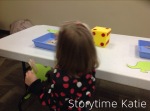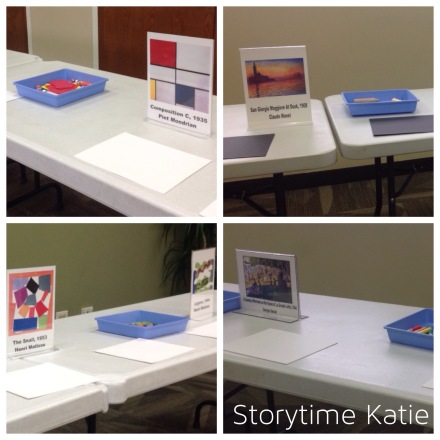
For set-up, I used our staff iPad and mirrored on the television with Apple TV. I sat on the counter underneath the TV and the kids piled in on the floor. This was another program that I planned in stages to help me choose from our myriad of iPad apps that we have on our in-house circulating equipment. I did purchase four apps for the program: “Wheels On the Bus”, “Peekaboo Vehicles”, and “Press Here” (for $1.99 each) and “Flip-Flap Safari” for $0.99.
Before I began the program, I talked a little about what we know about young children and new media. I mentioned the American Association of Pediatrics’s recommendation. And then I talked about using new media with young children in the library. (At the time this fabulous inforgraphic was not available, but you should use it going forward!)
My grand conclusion that I left them with is that parents/caregivers need to make the iPad/tablet an interactive experience as often as possible and that each family needed to decide for themselves what was appropriate for their child. And that’s what I was going to model today!
Dots

David Carter’s Spot the Dot
I started off the program using this app because I knew it would be a great icebreaker and a great way to model questions. While the kids scoured the television screen to find the dot, I modeled questions like: “What is the dot next to? Is it on the right side or left side? Is it big or little right now? Is it moving or flashing?” Kids answered the questions loudly and enthusiastically. I made sure to mention that in a one-on-one session it might be easiest to just touch the dot, but asking these questions brings in other concepts like size (math), spatial relations, etc.
Find Little Dot 1-10
Afterwards, I switched to another dot app. This is definitely more for babies and toddlers than preschoolers. But I took this opportunity to talk about the fact that apps can be aged and that older siblings can become the model in this situation. I asked each child to take a turn finding the dot with this app, which meant I walked around the room and let everyone touch the iPad. This was also a good learning experience since some of the children had never touched an iPad before. They now knew how hard to push to make something happen. (Like with my violin, some of them were extremely cautious!)
Press Here
I bought the book “Press Here” into the room with me. I put the iPad down for a second and took a book break. This was a great chance to talk about moderation to parents/caregivers. It also introduced my next kind of apps — ones that extend the book by having activities. After we read “Press Here”, I demonstrated some of the extras in the app. The kids were particularly taken with the fireworks section!
We moved on to Transportation apps next!
Transportation

Peekaboo Vehicles
Another app for the younger kids in the audience (the three-year-olds) that they really enjoyed. My tip to parents/caregivers for this app was that these kind of guessing games are excellent for long car trips. I also recommended having Animal Sounds installed on their phones. An adult or older sibling in the passenger seat can play the sound and have the preschooler guess what animal is it.
Byron Barton’s Planes
For this app, I talked about how flat a book can be when you read it. An iPad version of the same book allows for more interactions. I asked the kids what they wanted to “touch” to see more. In the Barton app, if you touch different areas of the app you can hear different words and names of items and places. The kids were fascinated and wanted to touch every part of the app.
Wheels on the Bus
So to end this session, I (and the app) led them in a spirited version of this popular song! We played the song several times and then recorded our own version. We played it back to a lot of giggles. I gave this tip to parents/caregivers: these apps that allow a recording can show a parent who was at work or on a business trip what was going on at the house while they were gone. Technology is a great tool for keeping in touch with family we don’t see every day.
And then it was on to animals!
Animals

Head, Shoulders, Knees, and Toes
This was a fun experience for the kids. We played along to each language and got up to stretch our muscles. For this app, I talked about expanding language needs using apps. Children who are interested in learning a new language or who are working on learning English as a Second Language can find supportive apps to increase their knowledge. Children learn languages much faster than adults, so now is the time to start if you’re interested!
Flip-Flap Safari
My only “app” disaster. It crashed twice as we were using it. It’s also a UK author so some of the word choices didn’t make too much sense for the kids. This is the only app that didn’t work well for me. I guess every program has to have one dud!
Don’t Let the Pigeon Run This App!
But we recovered easily with the Pigeon, aka every preschooler’s best friend. I read aloud the original version to make sure everyone knew the story before we delved into the app. We recorded our own very funny Pigeon story and the group left with lots of giggles under their belts. I once again reiterated about looking for opportunities to interact with apps and to not use them as babysitters.
How It Went
Planning the program using the small segments was brilliant on my part. The kids remained engaged and excited on each journey. I only had one child who kept getting up to try and touch the big screen (which no one can reach). His caregiver did a good job of chasing him down. Everything went incredibly well, even though I had a power outage/surge that required a re-set of Apple TV in the Transportation segment. Of course that would happen, haha!
























